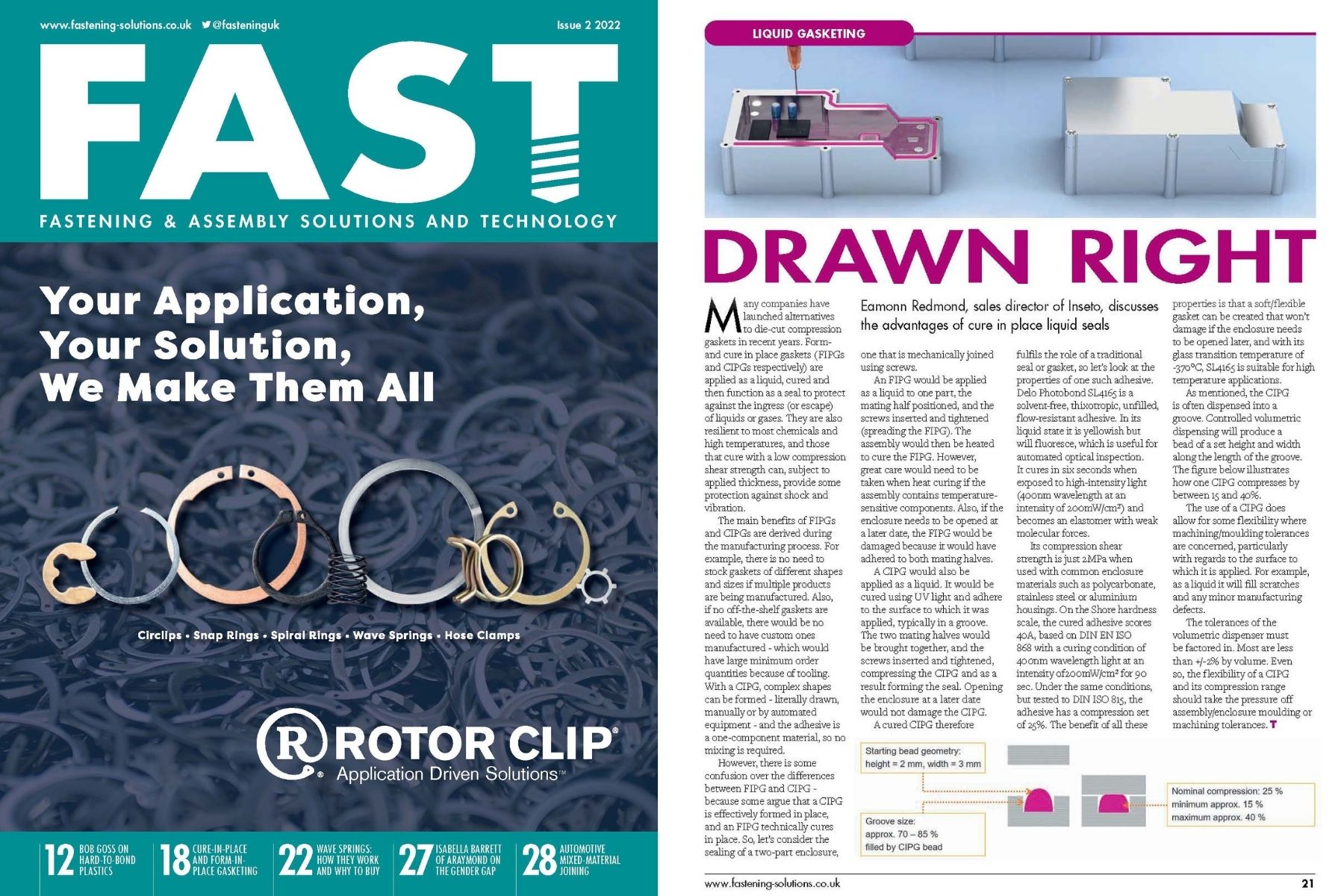Eamonn Redmond, Sales Director of Inseto discusses cure-in-place liquid seals.
In recent years many companies have launched alternatives to die-cut compression gaskets. Form- and cure-in-place gaskets (FIPGs and CIPGs respectively) are applied as a liquid, cured and then function as a seal to protect against the ingress (or escape) of liquids or gases.
They are also resilient to most chemicals and high temperatures, and those that cure with a low compression shear strength can, subject to applied thickness, provide some protection against shock and vibration.
The main benefits of FIPGs and CIPGs are derived during the manufacturing process. For example, there is no need to stock gaskets of different shapes and sizes if multiple products are being manufactured. Also, if no off-the-shelf gaskets are available there would be no need to have custom ones manufactured – which would have large MOQs because of tooling. With a CIPG, complex shapes can be formed – literally drawn, manually or by automated equipment – and the adhesive is a one-component material, so no mixing is required.
However, there is some confusion over the differences between FIPG and CIPG – because some argue that a CIPG is effectively formed in place, and an FIPG technically cures in place. So, let’s set the record straight by considering the sealing of a two-part enclosure, one that is mechanically joined using screws.
- An FIPG would be applied as a liquid to one part, the mating half positioned, and the screws inserted and tightened (spreading the FIPG). The assembly would then be heated to cure the FIPG. However, great care would need to be taken when heat curing if the assembly contains temperature sensitive components. Also, if the enclosure needs to be opened at a later date, the FIPG would be damaged because it would have adhered to both mating halves.
- A CIPG would also be applied as a liquid. It would be cured using UV light and adhere to the surface to which it was applied, typically in a groove. The two mating halves would be brought together, and the screws inserted and tightened, compressing the CIPG and as a result forming the seal. Opening the enclosure at a later date would not damage the CIPG.
A cured CIPG therefore fulfils the role of a traditional seal or gasket, so let’s look at the properties of one such adhesive. DELO® PHOTOBOND® SL4165 is a solvent-free, thixotropic, unfilled, flow-resistant adhesive. In its liquid state it is yellowish but will fluoresce, useful for AOI. It cures in 6 seconds when exposed to high-intensity light (400nm wavelength at an intensity of 200mW/cm2) and becomes an elastomer with weak molecular forces.
Its compression shear strength is just 2MPa when used with common enclosure materials such as polycarbonate, stainless steel or aluminium housings. On the Shore hardness scale, the cured adhesive scores 40A, based on DIN EN ISO 868 with a curing condition of 400nm wavelength light at an intensity of200mW/cm² for 90 s. Under the same conditions, but tested to DIN ISO 815, the adhesive has a compression set of 25%. The benefit of all these properties is that a soft/flexible gasket can be created that won’t damage if the enclosure needs to be opened later, and with its glass transition temperature of -37oC, SL4165 is suitable for high temperature applications.
As mentioned, the CIPG is often dispensed into a groove. Controlled volumetric dispensing will produce a bead of a set height and width along the length of the groove. Figure 1 illustrates how one CIPG compresses by between 15 and 40%.
The use of a CIPG does allow for some flexibility where machining/moulding tolerances are concerned, particularly with regards to the surface to which it is applied. For example, as a liquid it will fill scratches and any minor manufacturing defects.
The tolerances of the volumetric dispenser must be factored in. Most are less than +/-2% by volume. Even so, the flexibility of a CIPG and its compression range should take the pressure off assembly/enclosure moulding or machining tolerances.

